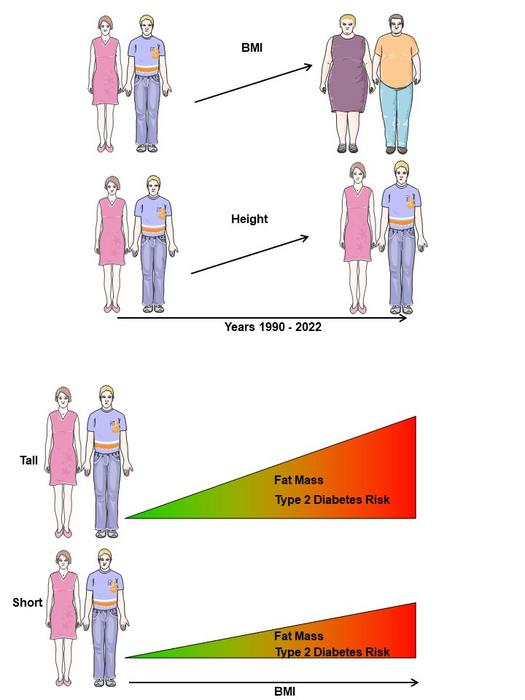Since 1990, the prevalence of obesity among children and adolescents (as measured by body mass index, BMI) has increased fourfold, while obesity rates among adults have more than doubled. This trend in the obesity epidemic is expected to elevate the risk of BMI-associated diseases, particularly cardiovascular diseases and type 2 diabetes.
Researchers from the German Center for Diabetes Research (DZD) hypothesised that the global increase in height over the past decades might influence BMI-associated cardiometabolic risk. In a recent study published in 'The Lancet Diabetes & Endocrinology', they present new data indicating that for the same BMI increase, taller individuals have higher fat mass and an elevated risk of type 2 diabetes. They suggest that the cardiometabolic risk associated with higher BMI may be underestimated in taller populations worldwide.
On World Obesity Day 2024 (March 4th), The Lancet published a study by the NCD Risk Factor Collaboration (NCD-RisC) in collaboration with the World Health Organization (WHO). This study analysed weight and height measurements from 222 million people across 200 countries and territories, using BMI to track changes in obesity and underweight from 1990 to 2022. The study found that over one billion people worldwide are currently living with obesity (defined as BMI ≥30 kg/m² in adults). Given the substantial disease burden related to high BMI—such as the 4 million deaths in 2015 (7.1% of all deaths), with cardiovascular disease and diabetes being the leading causes—an increase in BMI-associated diseases is anticipated.
The researchers argue that calculations of BMI-associated disease risk should consider other important trends in anthropometry, particularly height. BMI only approximates fat mass and is not necessarily independent of height. Importantly, from 1985 to 2020, the mean height of children and adolescents increased in most countries worldwide. In adolescents and young adults, moderate to large gains in height alongside small or no increases in BMI observed from 1985 to 2019 in some countries indicate a healthy trajectory. However, it is unknown whether increased height potentially modifies the significance of BMI as a measure of body fatness and cardiometabolic risk.

Image Credit: DZD
By analysing data from 972 subjects in the Tübingen Diabetes Family Study, the researchers found that the positive relationship between BMI and total body fat mass strengthened with increasing height in both women and men. This relationship was not affected by age or skeletal volume. They analysed data from 25,393 participants in the European Prospective Investigation into Cancer and Nutrition (EPIC)-Potsdam study. They discovered that the hazard ratios for a BMI difference of 5 kg/m² for type 2 diabetes, adjusted for confounders, increased from 1.58 in the shortest height category (≤150 cm) to 2.85 in the tallest height category (>180 cm).
The authors conclude that BMI better reflects fat mass and cardiometabolic risk in taller individuals than in shorter ones. They hypothesise that modern adults, being on average taller, may face a greater BMI-associated health burden than past populations with similar BMI. Therefore, it is crucial to account for the increase in height over recent decades to more accurately estimate the future burden of obesity-associated cardiometabolic diseases.
Source: Deutshes Zentrum Fuer Diabetesforschung DZD
Image Credit: DZD and iStock







